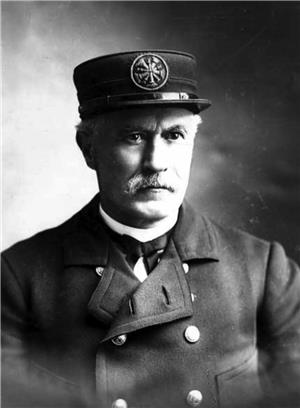On June 9, 1911, Frank L. Stetson is chosen as the Chief of the Seattle Fire Department. Stetson had been Chief of the Minneapolis Fire Department in the 1890s, and later created the Nome Volunteer Fire Department in Alaska during the Gold Rush. He was chosen for the top job in Seattle following a series of scandals, which prompt City officials to search out of town for candidates.
Seattle's first Fire Chief, Gardner Kellogg, retired from his second term in 1901 to take the job of Fire Marshall -- a job which allowed him to focus on fire prevention, his main concern. Ralph Cook took his place, and served for five years.
In 1906, Harry Bringhurst was named Chief, and working with Fire Marshall Kellogg, brought many positive changes to the department, including increased attention to fire prevention, motorized vehicles, and many new fire stations needed for recent annexations to the city of Seattle.
Hi Gill's Ill Will
Hiram C. "Hi" Gill (1866-1919) was elected mayor in 1910, and many of his supporters were businessmen who didn't like all the fire codes required for building construction. These same types of businessmen had unsuccessfully tried to oust Kellogg from the department back in the 1890s. Now they set their sights on Bringhurst.
The flap with Kellogg had ended with the creation of a City Charter in 1896 that prevented a Fire Chief from being fired without just cause. Therefore, Gill concocted his own "just cause," and fired Bringhurst because he wore civilian clothes to work. Gill replaced him with John Boyle, an able firefighter who also happened to be one of Gill"s card-playing buddies.
Gill supported an "open-town" policy where "vice" carried on in brothels, gambling parlors, and saloons went unsuppressed. Within a year, the city became a cesspool of crime, and Gill was recalled. The Chief of Police went to jail, and Fire Chief Boyle was in the spotlight for replacement.
On April 11, 1911, Boyle was asked to resign after complaints came in that he had used foul language during a fire at Lincoln High School. While under investigation, it was uncovered that Boyle also played favorites when it came to discipline, was involved in political activity, and frequented saloons too many times. He was fired on April 24, 1911. William Clark was named Interim Chief.
A Bad Day For All
That afternoon, while ex-Chief Boyle met with the new Chief to discuss the Department's problems, a large fire broke out at the Eyers Storage & Distributing Company at Railroad Avenue S and Washington Street. Firefighters, including Boyle, rushed to the scene.
While fighting the blaze, the Department's only aerial ladder in service had to be extended over some boxcars. The angle of the ladder caused it to collapse, sending several firefighters plummeting to the ground. Ex-Chief Boyle transported four of them to the hospital and was credited with saving at least one man's life.
Also during the blaze, the fireboat Duwamish began shooting water over the heads of spectators. When the water hit power lines, arcing occurred which sent people scattering in all directions. All in all, it was a bad day for the Seattle Fire Department, both internally and externally.
Mayor George Dilling (1869-1951), who had beaten Hi Gill in the recall election, believed that the only way the Fire Department could recover quickly from its failings was to hire a new Chief from out of town. Unfortunately, the troubled Department had received bad press around the country, and very few people wanted the job.
In Steps Stetson
One man who did want the job was Frank L. Stetson, who had left his position as Chief of the Minneapolis Fire Department in 1897 to develop the Nome Volunteer Fire Department in Alaska. Stetson was appointed on June 9, 1911 -- just three days after the 20th anniversary of Seattle's Great Fire (which occurred on June 6, 1889).
With the political climate still in disarray, some businessmen of low morals still looked for ways to ease fire codes and construct less expensive buildings -- fire safety be damned. They once again set their sights on Fire Marshall Gardner Kellogg, who had done more to improve the safety of buildings then anyone since the Great Fire.
By this time, Kellogg was over 70. Rather than fight these unscrupulous developers, he decided to retire. Much to his satisfaction, his old friend Ex-Chief Harry Bringhurst took his place. Bringhust and Stetson guided the Seattle Fire Department upwards for the next decade, improving the city's infrastructure for all citizens.

